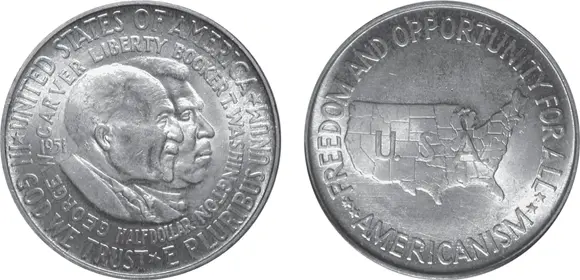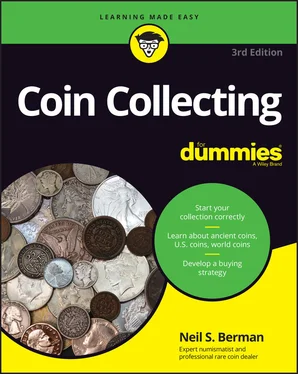Neil S. Berman - Coin Collecting For Dummies
Здесь есть возможность читать онлайн «Neil S. Berman - Coin Collecting For Dummies» — ознакомительный отрывок электронной книги совершенно бесплатно, а после прочтения отрывка купить полную версию. В некоторых случаях можно слушать аудио, скачать через торрент в формате fb2 и присутствует краткое содержание. Жанр: unrecognised, на английском языке. Описание произведения, (предисловие) а так же отзывы посетителей доступны на портале библиотеки ЛибКат.
- Название:Coin Collecting For Dummies
- Автор:
- Жанр:
- Год:неизвестен
- ISBN:нет данных
- Рейтинг книги:4 / 5. Голосов: 1
-
Избранное:Добавить в избранное
- Отзывы:
-
Ваша оценка:
- 80
- 1
- 2
- 3
- 4
- 5
Coin Collecting For Dummies: краткое содержание, описание и аннотация
Предлагаем к чтению аннотацию, описание, краткое содержание или предисловие (зависит от того, что написал сам автор книги «Coin Collecting For Dummies»). Если вы не нашли необходимую информацию о книге — напишите в комментариях, мы постараемся отыскать её.
Coin Collecting For Dummies,
numismatics
Coin Collecting For Dummies
Coin Collecting For Dummies — читать онлайн ознакомительный отрывок
Ниже представлен текст книги, разбитый по страницам. Система сохранения места последней прочитанной страницы, позволяет с удобством читать онлайн бесплатно книгу «Coin Collecting For Dummies», без необходимости каждый раз заново искать на чём Вы остановились. Поставьте закладку, и сможете в любой момент перейти на страницу, на которой закончили чтение.
Интервал:
Закладка:

 Demand is fickle. A series that’s in demand today may be out of favor tomorrow. Beware of fads, and take a contrarian approach when buying coins. In other words, stay away from the hot areas, and concentrate on the cool areas, remembering that every dog has its day. Demand may be artificial. With rare coins, it doesn’t take much to run up the price. Before buying a particular coin, do a little research to see how the price has trended over the past year or two. Has there been an unusual spike in the price, or has the price remained fairly stable?
Demand is fickle. A series that’s in demand today may be out of favor tomorrow. Beware of fads, and take a contrarian approach when buying coins. In other words, stay away from the hot areas, and concentrate on the cool areas, remembering that every dog has its day. Demand may be artificial. With rare coins, it doesn’t take much to run up the price. Before buying a particular coin, do a little research to see how the price has trended over the past year or two. Has there been an unusual spike in the price, or has the price remained fairly stable?
Rarity: Hunting for treasures
The rarity of a coin relates to the number of examples that have survived. A high mintage figure (meaning that lots of copies of a coin were made) doesn’t necessarily mean low rarity — or vice versa. The reported mintage figure for a 1927-D $20 gold piece, for example, is 180,000 pieces, which is fairly high, but this coin ranks as one of the all-time-great rarities in the series. Why? Experts suspect that most examples of this date were destroyed before they were released into circulation. On the other hand, a 1913-S $20 has a small reported mintage of only 34,000 pieces, yet there’s little or no premium attached to this coin in circulated condition. Why? Almost the entire mintage survived. In some cases, mintage figures may be incorrect or may include coins from an earlier or later year.
 Don’t rely on mintage figures alone to determine the rarity of a particular coin.
Don’t rely on mintage figures alone to determine the rarity of a particular coin.
Supply: Giving them what they want
If too many coins are made each year, and not enough people want them, prices remain low. On the other hand, if a coin’s supply falls short of demand, prices rise.
Back in 1986, when the PCGS began certifying U.S. coins, demand for their product was huge, and the supply was low, even though PCGS did its best to grade as efficiently as possible. I remember seeing my first PCGS-certified MS-65 common date Morgan silver dollar. It was a thing of beauty, all bright, shiny, and nearly perfect. It was also priced at $600. Now, many years later, hundreds of thousands of Morgan dollars have been certified by PCGS. Because the supply is large enough to satisfy the demand of most collectors, the price of a common-date PCGS-certified MS-65 Morgan dollar has dropped to less than $200.
A similar situation occurs each year when the new government-issued proof sets hit the market. The collectors who are lucky enough to receive the first sets often sell them for a nice profit, because everyone wants to own one. Later, as the U.S. Mint releases more sets, the price drops because supply rises to meet demand.
 Buy proof sets directly from the U.S. Mint each year if you like these kinds of coins. If you miss out for some reason, wait until the market has cooled down a bit and prices stabilize. You may be waiting for a few months, but be patient. In most cases, you’ll have to pay more than the issue price, but in general, you’ll avoid the hefty premiums that are charged when the supply is low.
Buy proof sets directly from the U.S. Mint each year if you like these kinds of coins. If you miss out for some reason, wait until the market has cooled down a bit and prices stabilize. You may be waiting for a few months, but be patient. In most cases, you’ll have to pay more than the issue price, but in general, you’ll avoid the hefty premiums that are charged when the supply is low.
 Supply and demand work opposite each other. Just as demand can be manipulated to raise prices, so can supply. Again, become aware of any funny business in the market by researching potential purchases carefully. Ask your adviser whether they know of any behind-the-scenes activity that may affect the supply of the coin in which you’re interested.
Supply and demand work opposite each other. Just as demand can be manipulated to raise prices, so can supply. Again, become aware of any funny business in the market by researching potential purchases carefully. Ask your adviser whether they know of any behind-the-scenes activity that may affect the supply of the coin in which you’re interested.
Deciding What to Collect
Because money is a limiting factor, no matter how much of it you have, figure out how much you want to budget for your collection and then decide where to spend it. Here are some suggestions for interesting and challenging ways to collect coins:
Denomination: Try putting together a complete set of all the denominations issued by the United States. Start with the coins in circulation and then include obsolete coins like a half cent, a 3-cent piece, and a 20-cent piece — coins that most people have never heard of.
Type: You’ll find several types within each denomination. Half dollars, for example, include the Flowing Hair, Draped Bust, Capped Bust, Seated Liberty, Barber, Walking Liberty, Franklin head, and Kennedy types. You can collect by type within a denomination, or you can expand into other denominations.
Date: Collecting by date is a fun and affordable way to obtain every date for a particular series. You could easily collect a half dollar from every year they were minted since 1900. There’s no reason to pay extra for a rare mintmark; just pick the least expensive coin for the year, and add it to your collection. Not only will you have one coin from every year, but you’ll also have added several different types along the way.
Date and mintmark combination: Collecting every date and mintmark combination becomes a bit more challenging and expensive. Most series have what I call a stopper — a rare mintmark that can be prohibitively expensive. Believe me, you don’t want to attempt to collect a set of Barber dimes unless you have a lot of money. You may find and be able to afford every date in the series except for the extremely rare 1894-S, but you’ll need $1 million or more for a nice one! On the other hand, you can complete several series without breaking the bank. If you can’t afford the Barber dime set, try the Barber half dollars instead. The coins are bigger, and every date and mintmark in the set is affordable. Keep in mind that until recently, coins minted in Philadelphia had no mintmark.
Year: Many people try to buy every coin issued in the year of their birth. If you’re younger than 50, all you have to do is buy the mint set and proof sets issued by the government in the year of your birth, along with any commemorative coins issued that year. If you’re older than 50, you may have to search a little harder — but that’s half the fun of collecting coins, isn’t it? If you really want to go all out, try collecting coins issued in your birth year by other countries!
Staying focused
After you decide on a collecting plan, stick with it. Focus on your goals, and remain immune to the siren call of other coins. I know that temptation is hard to resist, but to conserve your resources and be ready when buying opportunities arise, you must remain strong.
Though I recommend sticking with your game plan, I don’t want to say that you can never change your mind. But there’s an important reason not to get distracted — a little thing called transaction costs.
Transaction costs are the fees you pay to get in and out of the coin market. If you’re familiar with the stock market, you know a different name for transaction costs: commissions. When you buy a stock, you’re charged a commission based on the price of the stock; when you sell a stock, you’re charged a commission again. Because the commissions come out of your pocket, you must figure them into your cost of the stock and the amount of any profits or losses that you make when you sell the stock. In many cases, commissions can eat up all your profits or enlarge your losses.
Читать дальшеИнтервал:
Закладка:
Похожие книги на «Coin Collecting For Dummies»
Представляем Вашему вниманию похожие книги на «Coin Collecting For Dummies» списком для выбора. Мы отобрали схожую по названию и смыслу литературу в надежде предоставить читателям больше вариантов отыскать новые, интересные, ещё непрочитанные произведения.
Обсуждение, отзывы о книге «Coin Collecting For Dummies» и просто собственные мнения читателей. Оставьте ваши комментарии, напишите, что Вы думаете о произведении, его смысле или главных героях. Укажите что конкретно понравилось, а что нет, и почему Вы так считаете.












